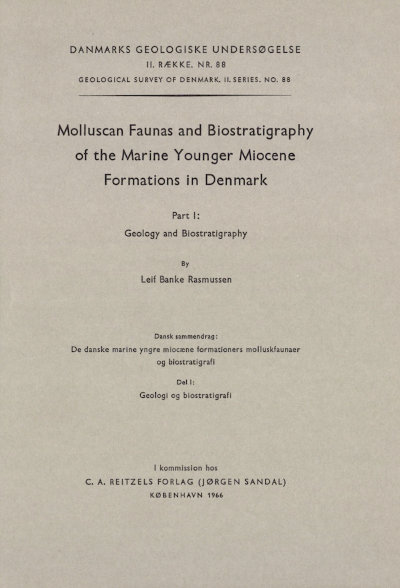Molluscan Faunas and Biostratigraphy of the Marine Younger Miocene Formations in Denmark. Part I: Geology and Biostratigraphy
DOI:
https://doi.org/10.34194/raekke2.v88.6879Abstract
The result of biostratigraphical investigations into the marine Younger Miocene formations in Denmark on the basis of the molluscan faunas shows the presence of six assemblage zones, distributed by two on the older formation, viz. the Hodde Formation, and four on the younger formation, viz. the Gram Formation:
Upper Miocene (Gram Formation):
The Nassa slieswicia zoneThe Astarte reimersi - Nuculana pygmaea zone
The Astarte reimersi - Goodallia esbjergensis zone
The Astarte vetula zone
Late Middle Miocene (Hodde Formation):
The Nassa fuchsi - Limopsis lamellata zoneThe Nassa cimbrica - Aquilofusus festivus zone.
In Denmark all the zones have only been recorded from West and Central Jutland and North Slesvig. So far they all seem to be distributed over the same region, except for the Nassa slieswicia zone, which has so far been recorded only from the region farthest south, close to the Danish-German frontier.
The marine Younger Miocene formations in Denmark include an unbroken, at least 35 m. thick series of clay, consisting at the bottom of Hodde Clay (belonging to the Hodde Formation), above that of Glauconite Clay, and at the top of Gram Clay (the last two belonging to the Gram Formation). Fairly homogeneous bottom conditions make it possible to follow the evolution of a few species from the Hodde Clay to the uppermost parts of the Gram Clay.
The basis of the investigations is partly collected, partly sorted-out material from about 90 localities scattered over the whole area of distribution. The most important basis, however, is a borehole at Gram in North Slesvig, where the complete series of clay was penetrated, and a borehole at Sæd, also in North Slesvig. Most of the other localities have only yielded fossils from a few assemblage zones. The geological conditions in the main part of the localities show that the series of clay to a great extent has been glacially deformed in the Quaternary Period, which has to some degree complicated the stratigraphical investigations.
It has been tried to substantiate the results mentioned through rather a detailed mention of the geological conditions in each locality and through analyses of the sampled and sorted-out fauna from each locality.
Downloads
Published
Issue
Section
License
This article is distributed under a CC-BY 4.0 licence, permitting free redistribution and reproduction for any purpose, even commercial, provided proper citation of the original work. Author(s) retain copyright over the article contents.


